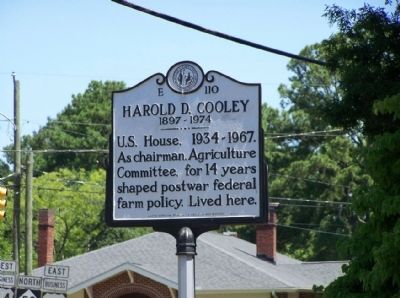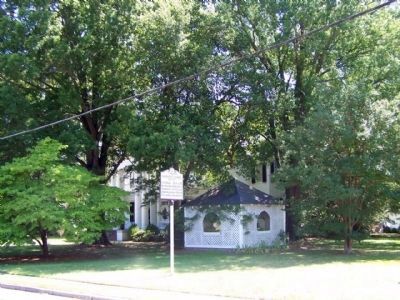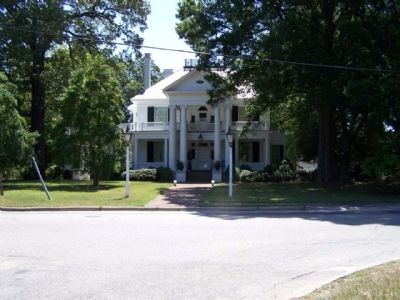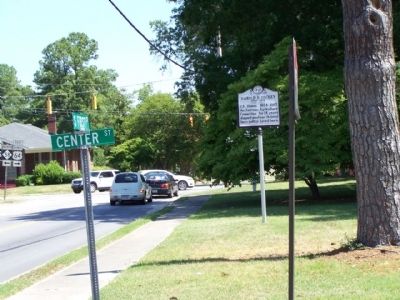Nashville in Nash County, North Carolina — The American South (South Atlantic)
Harold D. Cooley
1897 - 1974
Erected 2004 by North Carolina Office of Archives and History. (Marker Number E-110.)
Topics and series. This historical marker is listed in this topic list: Agriculture. In addition, it is included in the North Carolina Division of Archives and History series list.
Location. 35° 58.378′ N, 77° 57.671′ W. Marker is in Nashville, North Carolina, in Nash County. Marker is at the intersection of South 1st Street (North Carolina Route 58) and East Center Street, on the right when traveling north on South 1st Street. Touch for map. Marker is at or near this postal address: 105 S 1st St, Nashville NC 27856, United States of America. Touch for directions.
Other nearby markers. At least 8 other markers are within 9 miles of this marker, measured as the crow flies. Nash County Vietnam Veterans Memorial (approx. 8.2 miles away); Agent Orange Victims (approx. 8.2 miles away); Lafayette (approx. 8.8 miles away); Falls of the Tar Church (approx. 8.8 miles away); Donaldson's Tavern (approx. 8.8 miles away); Falls Road Bridge (approx. 8.8 miles away); First Post Office of Rocky Mount (approx. 8.8 miles away); Cornwallis (approx. 8.9 miles away).
Regarding Harold D. Cooley. As longtime chairman of the U.S. House of Representatives Agriculture Committee, Harold Dunbar Cooley, native of Nashville, North Carolina, was a powerful spokesman for farmers from the New Deal to the Great Society. Educated at the University of North Carolina and at Yale law school, Democrat Cooley, by virtue of a special election in July 1934, filled the House seat in the North Carolina Fourth District vacated with the death of Edward W. Pou of Smithfield, himself a 33-year veteran of Congress. Cooley’s campaign slogan was “New Man for a New Day,” exploiting pro-New Deal sentiment. He would be re-elected without serious opposition until the 1960s. As a result, he served seventeen terms in the U.S. House. His length of service as Agriculture Committee chairman (from 1949 to 1952 and from 1955 to 1967, interrupted by the 83rd Congress when Republicans held the majority) has not been exceeded. Cooley lost his seat in 1966 to Republican James W. Gardner.
Cooley joined the Agriculture Committee during the height of the New Deal and was a driving force in the development of Roosevelt’s agricultural program. He backed several reforms including those that provided for allotments, price supports, rural electrification, and soil conservation. Cooley also sought to reach the world market with agricultural products, endorsing the “Food for Freedom” program as part of the Marshall Plan. He stated that “bread and butter rather than bullets and bayonets are the most powerful weapons in our arsenal.”
Cooley returned to North Carolina after losing his re-election campaign of 1966, and to the home in Nashville that he and his wife, Madeline, had acquired soon after their marriage in 1923. The structure, the Bissette-Cooley House designed and constructed around 1911 by architect John C. Stout, is prominently located on East Washington Street. He often told friends that Nashville was the “dearest place on earth” for him. Cooley died on January 15, 1974, at Wilson Memorial Hospital from the effects of emphysema. He was buried in Forest Hill Cemetery in Nashville. Upon hearing of Cooley’s death, Governor James B. Hunt Jr. said that Cooley was a “protector and defender” of North Carolina’s farmers and that Cooley “did more than anyone in Congress since the Depression to build a strong rural economy in America.”
(North Carolina Office of Archives and History)
Credits. This page was last revised on April 29, 2023. It was originally submitted on August 9, 2011, by Mike Stroud of Bluffton, South Carolina. This page has been viewed 515 times since then and 30 times this year. Last updated on April 29, 2023, by Michael Buckner of Durham, North Carolina. Photos: 1, 2, 3, 4. submitted on August 9, 2011, by Mike Stroud of Bluffton, South Carolina. • Bernard Fisher was the editor who published this page.



